
December 9, 2020 Goldman Sachs U.S. Financial Services Conference Ronald P. O’Hanley Chairman & Chief Executive Officer
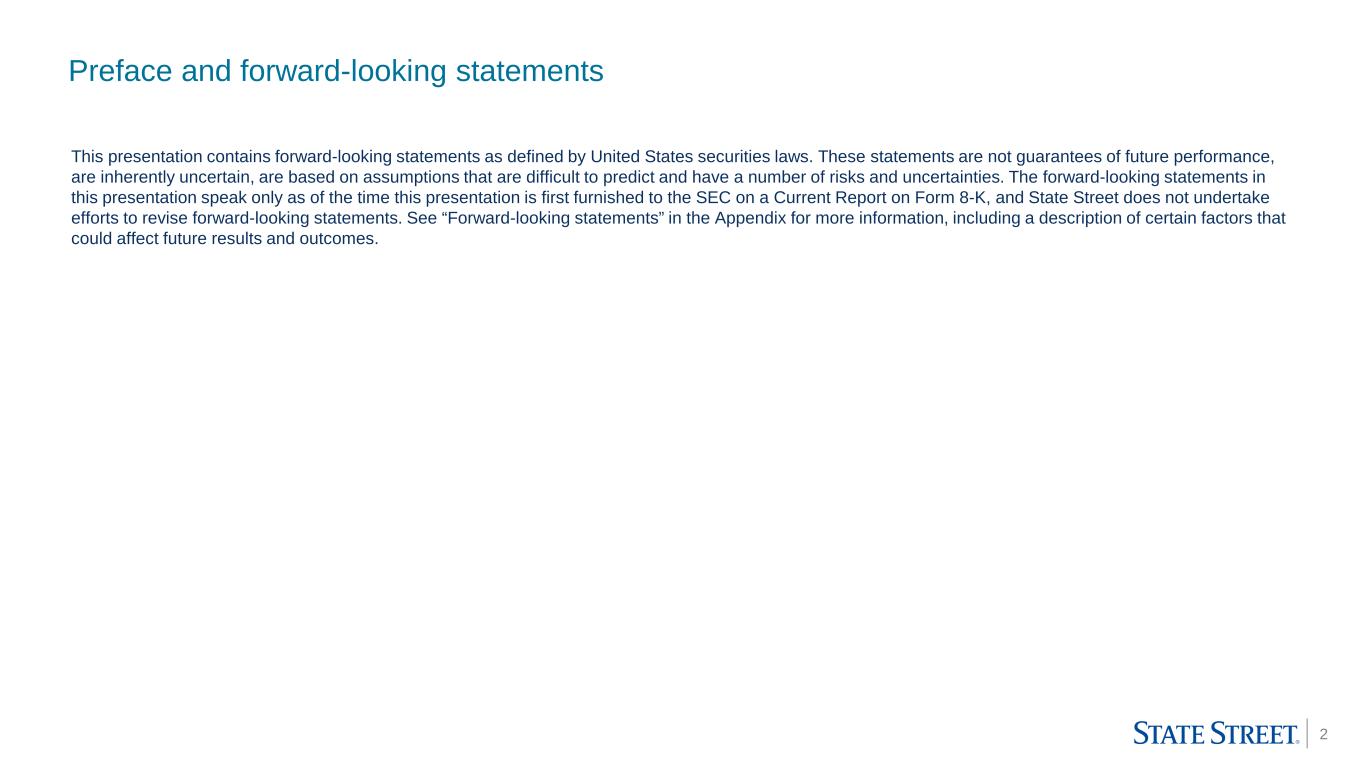
2 Preface and forward-looking statements This presentation contains forward-looking statements as defined by United States securities laws. These statements are not guarantees of future performance, are inherently uncertain, are based on assumptions that are difficult to predict and have a number of risks and uncertainties. The forward-looking statements in this presentation speak only as of the time this presentation is first furnished to the SEC on a Current Report on Form 8-K, and State Street does not undertake efforts to revise forward-looking statements. See “Forward-looking statements” in the Appendix for more information, including a description of certain factors that could affect future results and outcomes.
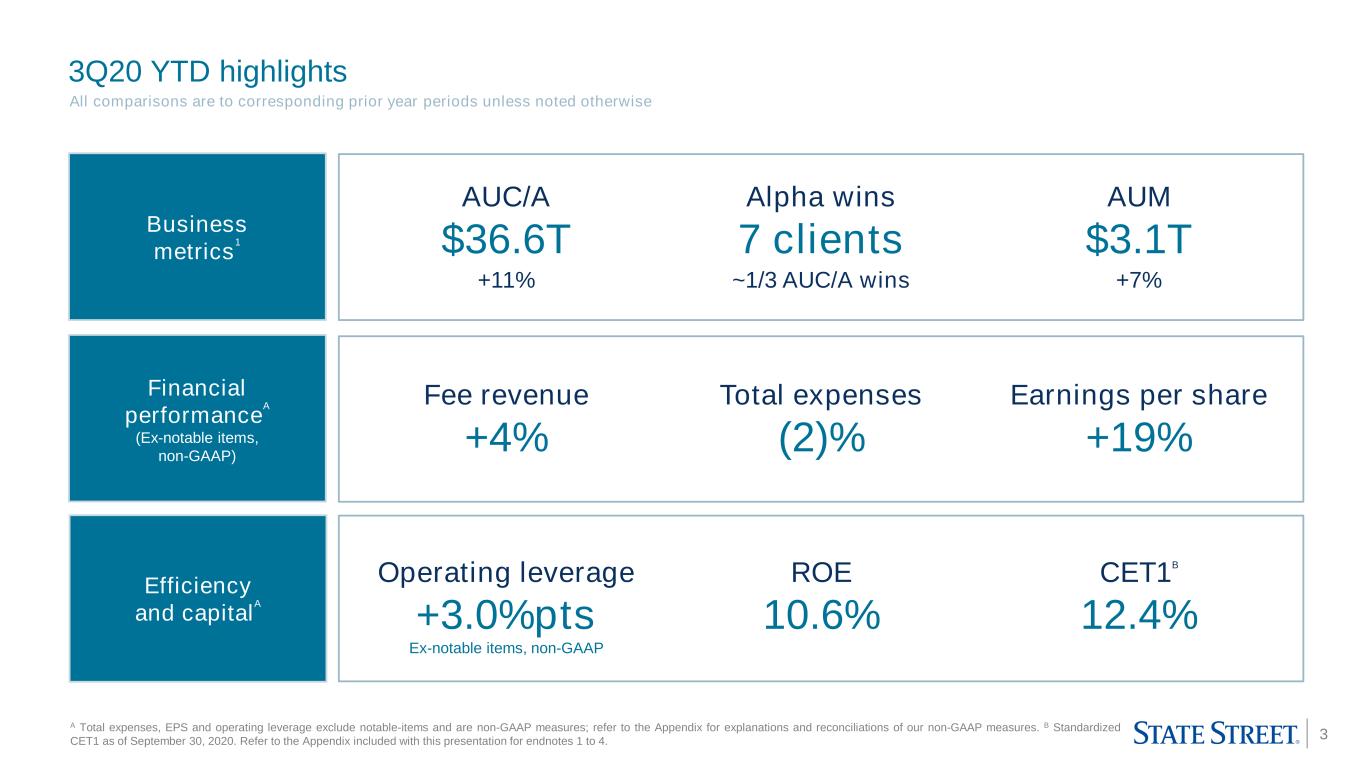
3 3Q20 YTD highlights Business metrics1 Financial performanceA (Ex-notable items, non-GAAP) A Total expenses, EPS and operating leverage exclude notable-items and are non-GAAP measures; refer to the Appendix for explanations and reconciliations of our non-GAAP measures. B Standardized CET1 as of September 30, 2020. Refer to the Appendix included with this presentation for endnotes 1 to 4. AUC/A $36.6T AUM $3.1T +7%+11% Earnings per share +19% ROE 10.6% Operating leverage +3.0%pts Ex-notable items, non-GAAP Total expenses (2)% All comparisons are to corresponding prior year periods unless noted otherwise CET1B 12.4% Alpha wins 7 clients ~1/3 AUC/A wins Fee revenue +4% Efficiency and capitalA
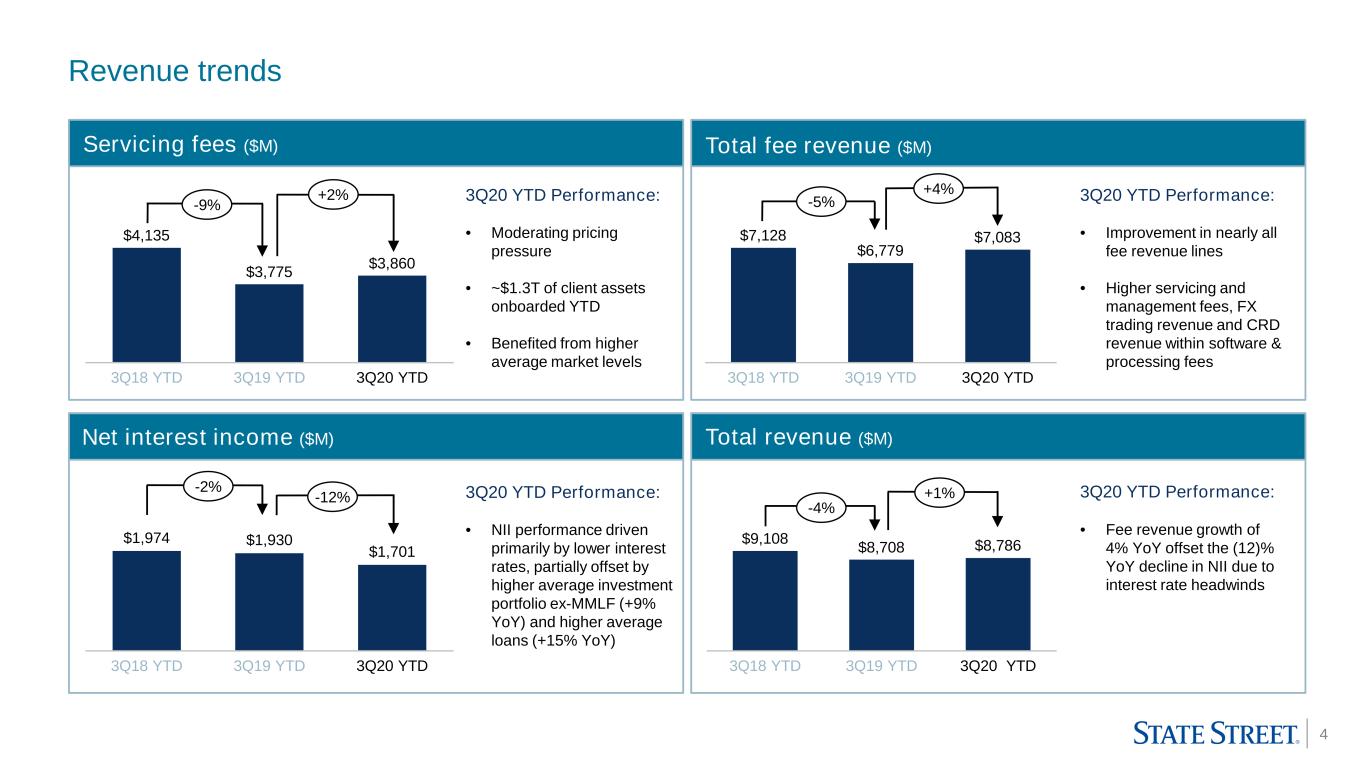
4 +2% Revenue trends $3,775 3Q18 YTD 3Q19 YTD 3Q20 YTD $3,860 $4,135 Servicing fees ($M) Total fee revenue ($M) Total revenue ($M) $7,128 3Q20 YTD3Q18 YTD 3Q19 YTD $6,779 $7,083 3Q20 YTD Performance: • Fee revenue growth of 4% YoY offset the (12)% YoY decline in NII due to interest rate headwinds 3Q20 YTD Performance: • Moderating pricing pressure • ~$1.3T of client assets onboarded YTD • Benefited from higher average market levels 3Q20 YTD Performance: • Improvement in nearly all fee revenue lines • Higher servicing and management fees, FX trading revenue and CRD revenue within software & processing fees 3Q18 YTD 3Q20 YTD3Q19 YTD $9,108 $8,708 $8,786 Net interest income ($M) 3Q20 YTD Performance: • NII performance driven primarily by lower interest rates, partially offset by higher average investment portfolio ex-MMLF (+9% YoY) and higher average loans (+15% YoY) $1,974 $1,930 $1,701 3Q19 YTD3Q18 YTD 3Q20 YTD -2% -12% -5%+2% +4% -4% +1% -9%

5 Strategically pivoting Investment Services to an enterprise outsource solutions model Institutional Services State Street AlphaSM Operating Model Enhanced go-to-market strategy with better product capabilities and stronger client coverage across segments and regions Enterprise outsourcing capabilities are underpinned by our integrated front-to-back Alpha platform solution Improving productivity and driving automation benefits will enable a comprehensive transformation of how we compete and operate Enterprise Outsource Solutions Provider Client coverage & capabilities Unique client value proposition Operational efficiency
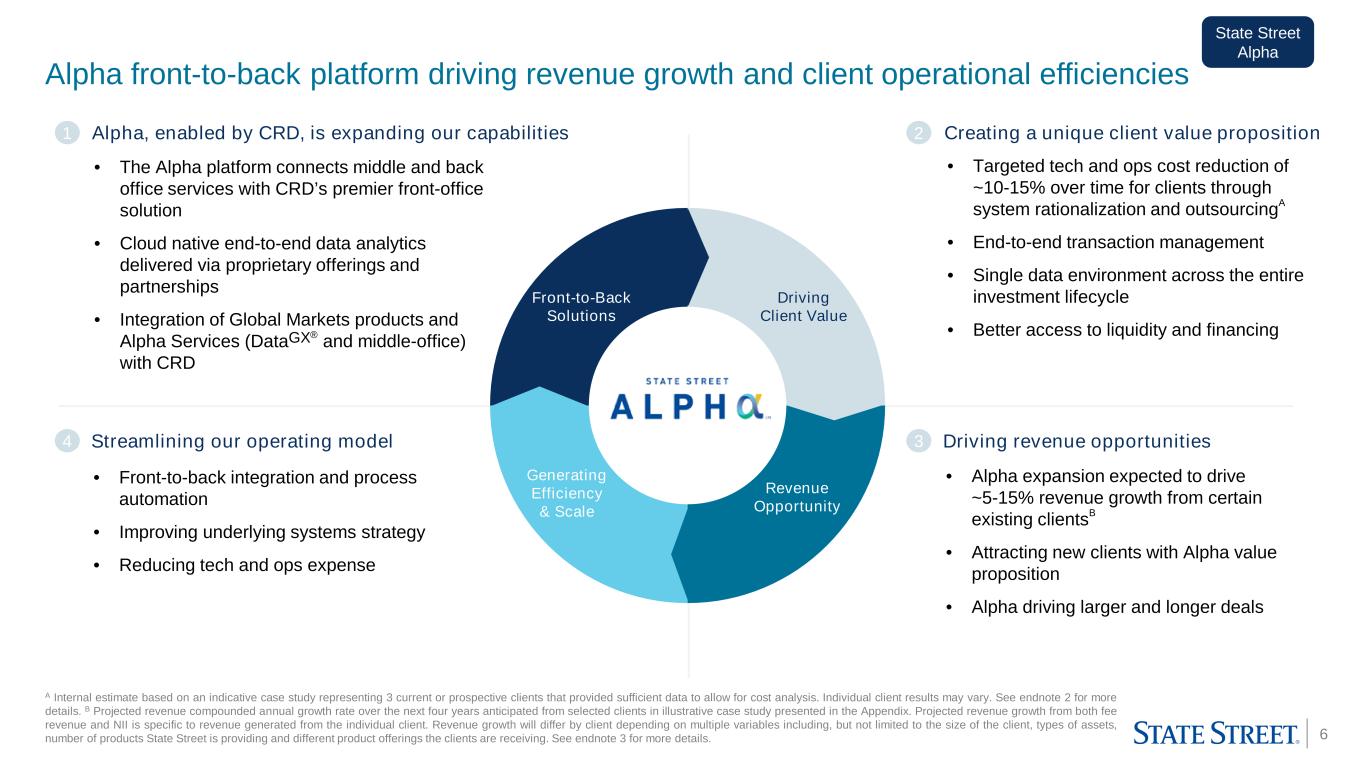
6 • Alpha expansion expected to drive ~5-15% revenue growth from certain existing clientsB • Attracting new clients with Alpha value proposition • Alpha driving larger and longer deals Driving revenue opportunities • The Alpha platform connects middle and back office services with CRD’s premier front-office solution • Cloud native end-to-end data analytics delivered via proprietary offerings and partnerships • Integration of Global Markets products and Alpha Services (DataGX® and middle-office) with CRD Alpha, enabled by CRD, is expanding our capabilities Alpha front-to-back platform driving revenue growth and client operational efficiencies Creating a unique client value proposition • Targeted tech and ops cost reduction of ~10-15% over time for clients through system rationalization and outsourcingA • End-to-end transaction management • Single data environment across the entire investment lifecycle • Better access to liquidity and financing Streamlining our operating model • Front-to-back integration and process automation • Improving underlying systems strategy • Reducing tech and ops expense A Internal estimate based on an indicative case study representing 3 current or prospective clients that provided sufficient data to allow for cost analysis. Individual client results may vary. See endnote 2 for more details. B Projected revenue compounded annual growth rate over the next four years anticipated from selected clients in illustrative case study presented in the Appendix. Projected revenue growth from both fee revenue and NII is specific to revenue generated from the individual client. Revenue growth will differ by client depending on multiple variables including, but not limited to the size of the client, types of assets, number of products State Street is providing and different product offerings the clients are receiving. See endnote 3 for more details. Front-to-Back Solutions Driving Client Value Revenue Opportunity Generating Efficiency & Scale State Street Alpha 1 2 34
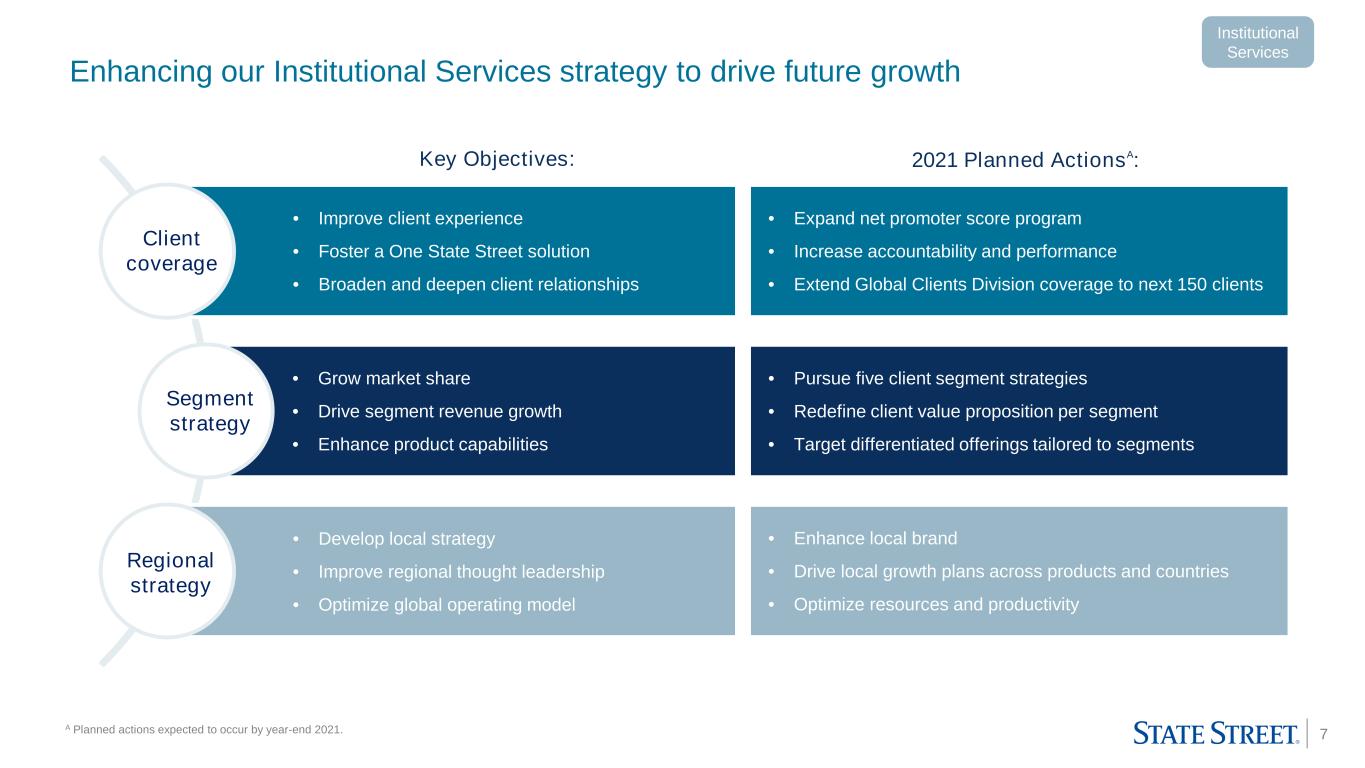
7 Enhancing our Institutional Services strategy to drive future growth Client coverage Segment strategy Regional strategy Key Objectives: • Improve client experience • Foster a One State Street solution • Broaden and deepen client relationships • Expand net promoter score program • Increase accountability and performance • Extend Global Clients Division coverage to next 150 clients • Grow market share • Drive segment revenue growth • Enhance product capabilities • Develop local strategy • Improve regional thought leadership • Optimize global operating model • Pursue five client segment strategies • Redefine client value proposition per segment • Target differentiated offerings tailored to segments • Enhance local brand • Drive local growth plans across products and countries • Optimize resources and productivity 2021 Planned ActionsA: A Planned actions expected to occur by year-end 2021. Institutional Services
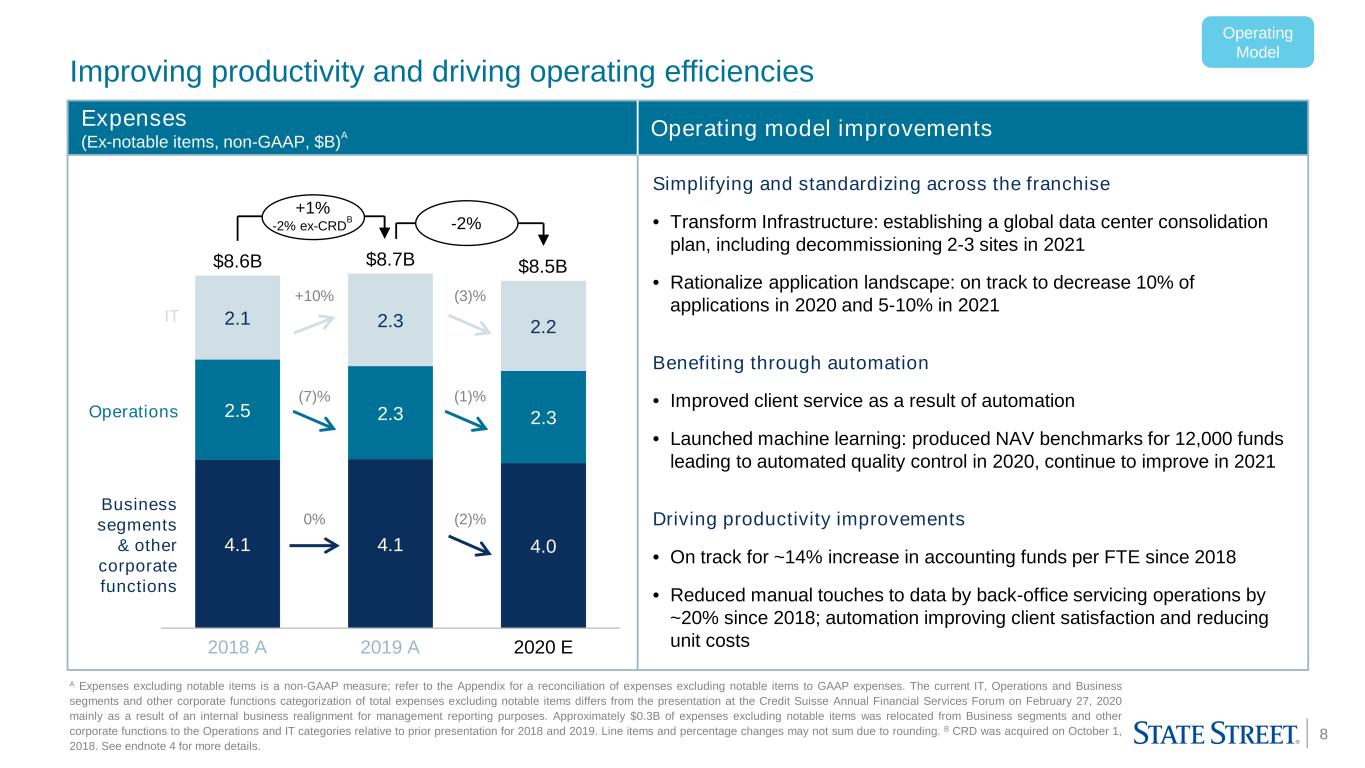
8 Improving productivity and driving operating efficiencies Expenses (Ex-notable items, non-GAAP, $B)A Operating model improvements Operations IT Business segments & other corporate functions 4.1 4.1 4.0 2.5 2.3 2.1 2.3 2.2 $8.5B 2.3 2018 A 2019 A 2020 E $8.6B $8.7B +10% (7)% 0% (2)% (1)% (3)% Operating Model Simplifying and standardizing across the franchise • Transform Infrastructure: establishing a global data center consolidation plan, including decommissioning 2-3 sites in 2021 • Rationalize application landscape: on track to decrease 10% of applications in 2020 and 5-10% in 2021 Benefiting through automation • Improved client service as a result of automation • Launched machine learning: produced NAV benchmarks for 12,000 funds leading to automated quality control in 2020, continue to improve in 2021 Driving productivity improvements • On track for ~14% increase in accounting funds per FTE since 2018 • Reduced manual touches to data by back-office servicing operations by ~20% since 2018; automation improving client satisfaction and reducing unit costs A Expenses excluding notable items is a non-GAAP measure; refer to the Appendix for a reconciliation of expenses excluding notable items to GAAP expenses. The current IT, Operations and Business segments and other corporate functions categorization of total expenses excluding notable items differs from the presentation at the Credit Suisse Annual Financial Services Forum on February 27, 2020 mainly as a result of an internal business realignment for management reporting purposes. Approximately $0.3B of expenses excluding notable items was relocated from Business segments and other corporate functions to the Operations and IT categories relative to prior presentation for 2018 and 2019. Line items and percentage changes may not sum due to rounding. B CRD was acquired on October 1, 2018. See endnote 4 for more details. +1% -2% ex-CRD B -2%
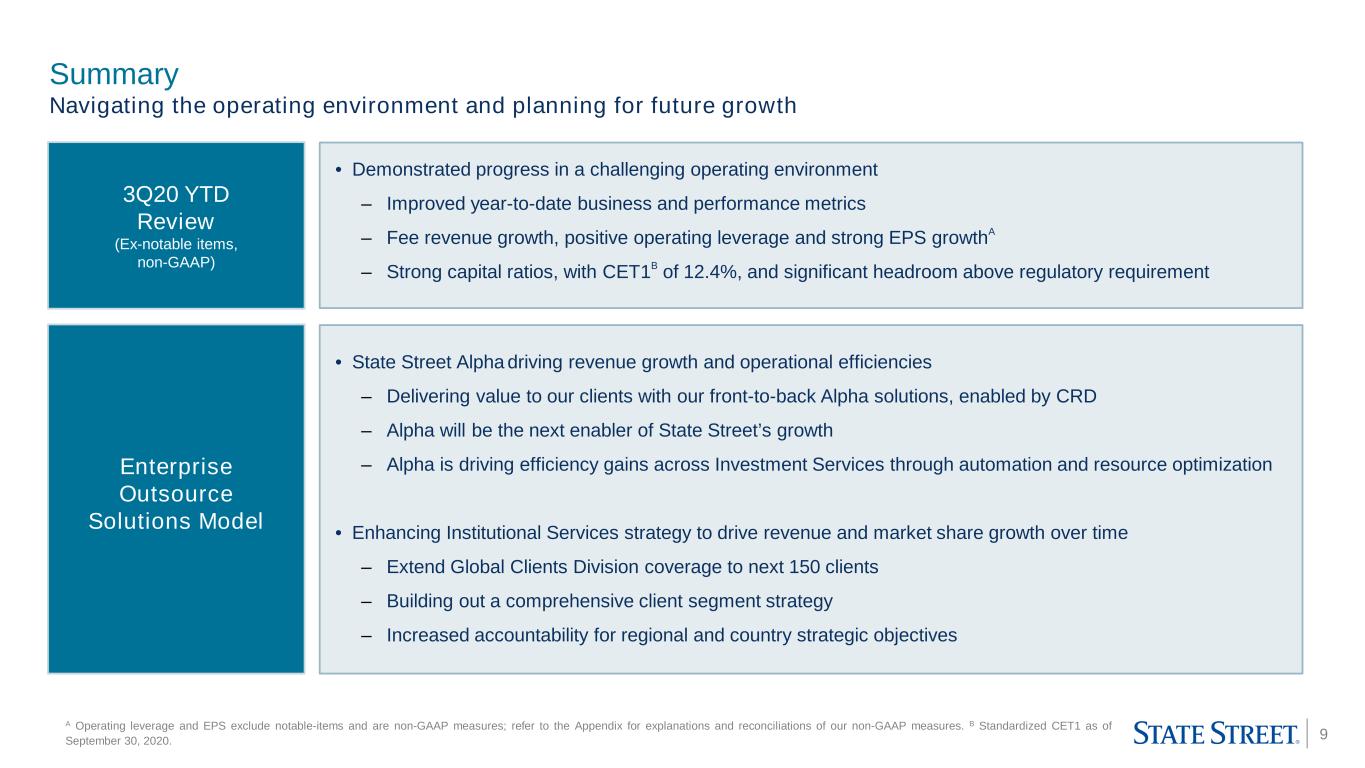
9 Enterprise Outsource Solutions Model 3Q20 YTD Review (Ex-notable items, non-GAAP) Summary Navigating the operating environment and planning for future growth • Demonstrated progress in a challenging operating environment – Improved year-to-date business and performance metrics – Fee revenue growth, positive operating leverage and strong EPS growthA – Strong capital ratios, with CET1B of 12.4%, and significant headroom above regulatory requirement A Operating leverage and EPS exclude notable-items and are non-GAAP measures; refer to the Appendix for explanations and reconciliations of our non-GAAP measures. B Standardized CET1 as of September 30, 2020. • State Street Alpha driving revenue growth and operational efficiencies – Delivering value to our clients with our front-to-back Alpha solutions, enabled by CRD – Alpha will be the next enabler of State Street’s growth – Alpha is driving efficiency gains across Investment Services through automation and resource optimization • Enhancing Institutional Services strategy to drive revenue and market share growth over time – Extend Global Clients Division coverage to next 150 clients – Building out a comprehensive client segment strategy – Increased accountability for regional and country strategic objectives

10 Fireside Chat & Q&A Ronald P. O’Hanley Eric Aboaf Alex Blostein
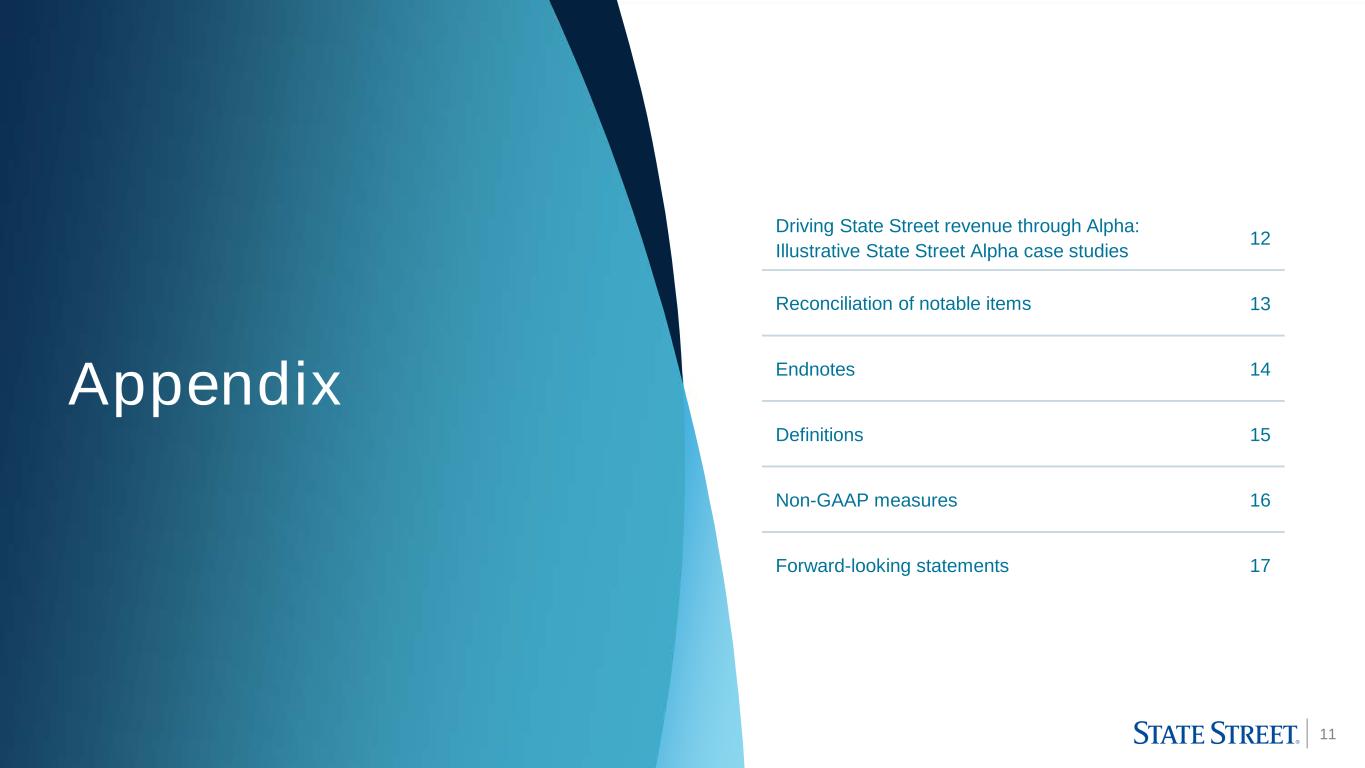
11 Appendix Driving State Street revenue through Alpha: Illustrative State Street Alpha case studies 12 Reconciliation of notable items 13 Endnotes 14 Definitions 15 Non-GAAP measures 16 Forward-looking statements 17
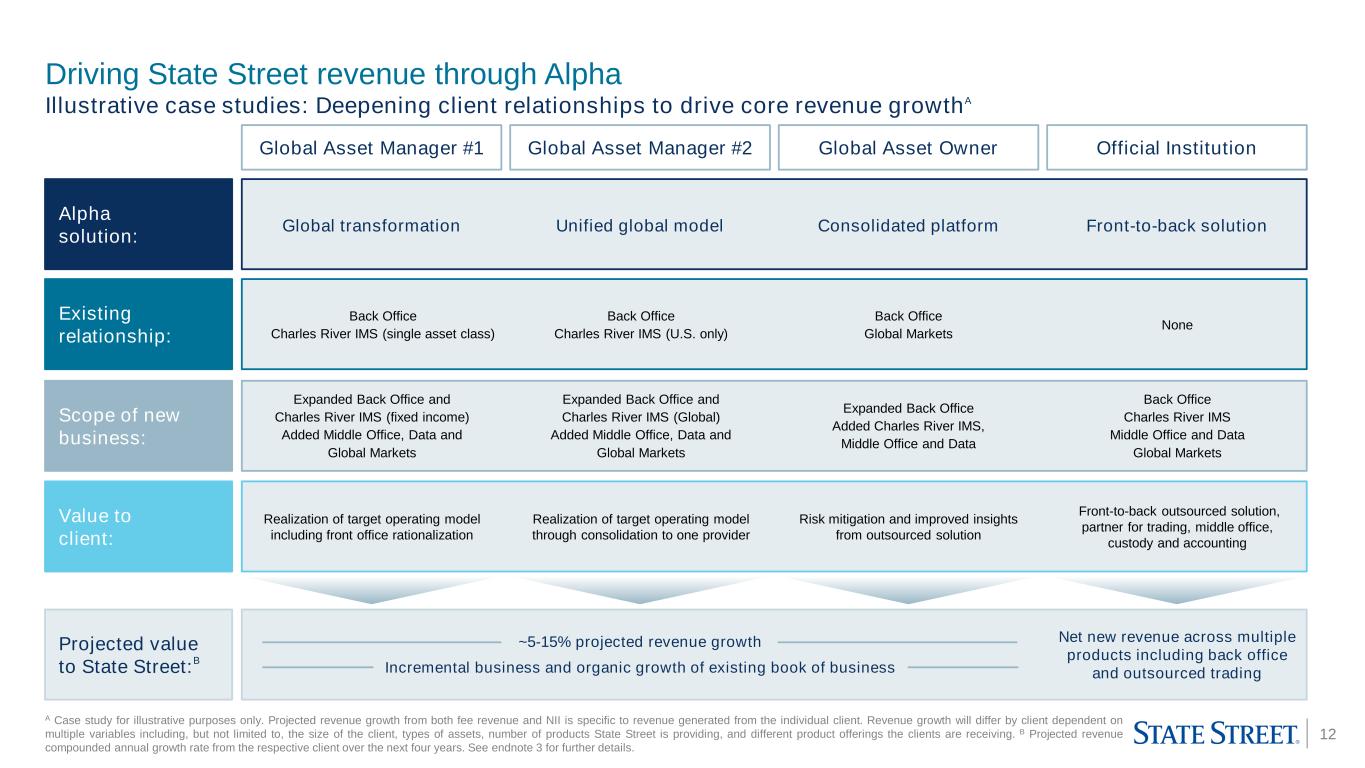
12 A Case study for illustrative purposes only. Projected revenue growth from both fee revenue and NII is specific to revenue generated from the individual client. Revenue growth will differ by client dependent on multiple variables including, but not limited to, the size of the client, types of assets, number of products State Street is providing, and different product offerings the clients are receiving. B Projected revenue compounded annual growth rate from the respective client over the next four years. See endnote 3 for further details. Driving State Street revenue through Alpha Illustrative case studies: Deepening client relationships to drive core revenue growthA Global Asset Manager #1 Global Asset Manager #2 Global Asset Owner Official Institution Alpha solution: Existing relationship: Scope of new business: Value to client: Projected value to State Street:B Global transformation Unified global model Consolidated platform Front-to-back solution Back Office Charles River IMS (single asset class) Back Office Charles River IMS (U.S. only) Back Office Global Markets None Expanded Back Office and Charles River IMS (fixed income) Added Middle Office, Data and Global Markets Expanded Back Office and Charles River IMS (Global) Added Middle Office, Data and Global Markets Expanded Back Office Added Charles River IMS, Middle Office and Data Back Office Charles River IMS Middle Office and Data Global Markets Realization of target operating model including front office rationalization Realization of target operating model through consolidation to one provider Risk mitigation and improved insights from outsourced solution Front-to-back outsourced solution, partner for trading, middle office, custody and accounting Net new revenue across multiple products including back office and outsourced trading ~5-15% projected revenue growth Incremental business and organic growth of existing book of business
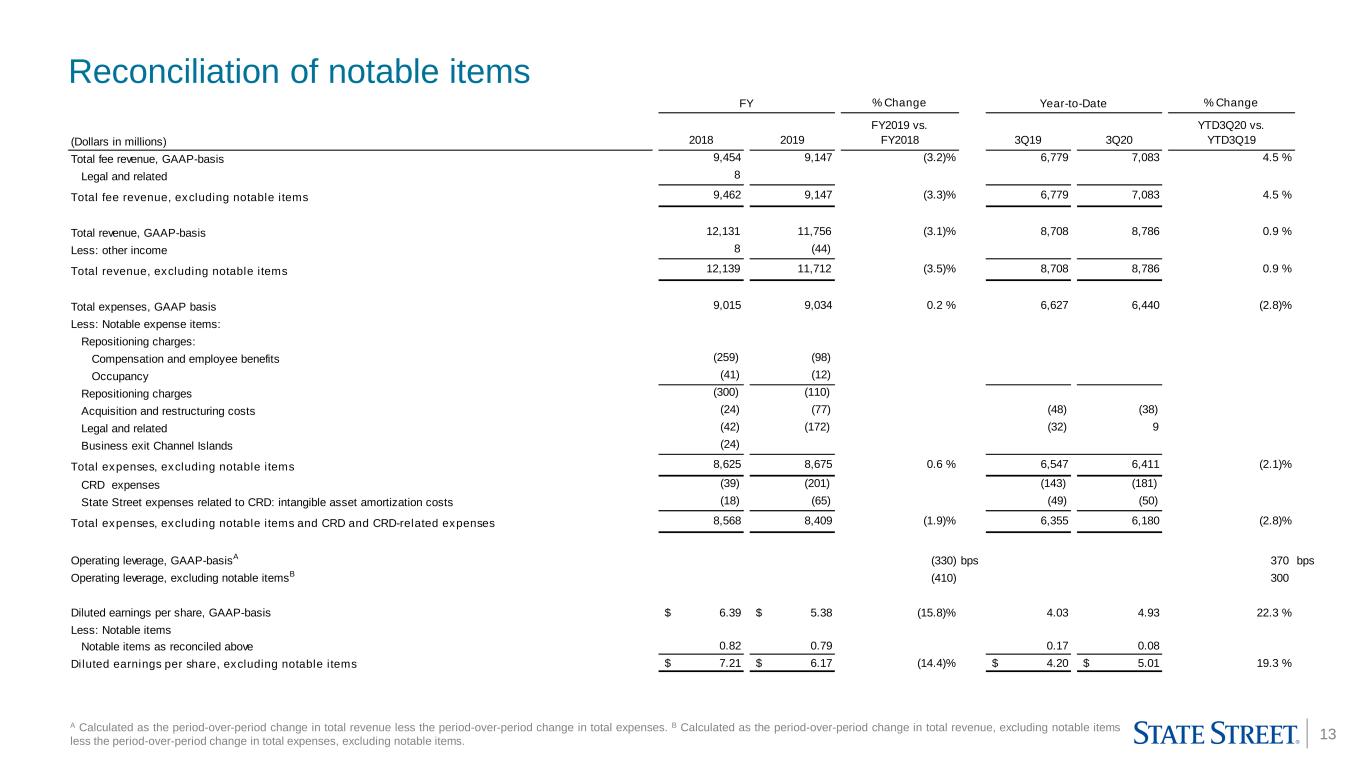
13 Reconciliation of notable items A Calculated as the period-over-period change in total revenue less the period-over-period change in total expenses. B Calculated as the period-over-period change in total revenue, excluding notable items less the period-over-period change in total expenses, excluding notable items. % Change % Change (Dollars in millions) 2018 2019 FY2019 vs. FY2018 3Q19 3Q20 YTD3Q20 vs. YTD3Q19 Total fee revenue, GAAP-basis 9,454 9,147 (3.2)% 6,779 7,083 4.5 % Legal and related 8 Total fee revenue, excluding notable items 9,462 9,147 (3.3)% 6,779 7,083 4.5 % Total revenue, GAAP-basis 12,131 11,756 (3.1)% 8,708 8,786 0.9 % Less: other income 8 (44) Total revenue, excluding notable items 12,139 11,712 (3.5)% 8,708 8,786 0.9 % Total expenses, GAAP basis 9,015 9,034 0.2 % 6,627 6,440 (2.8)% Less: Notable expense items: Repositioning charges: Compensation and employee benefits (259) (98) Occupancy (41) (12) Repositioning charges (300) (110) Acquisition and restructuring costs (24) (77) (48) (38) Legal and related (42) (172) (32) 9 Business exit Channel Islands (24) Total expenses, excluding notable items 8,625 8,675 0.6 % 6,547 6,411 (2.1)% CRD expenses (39) (201) (143) (181) State Street expenses related to CRD: intangible asset amortization costs (18) (65) (49) (50) Total expenses, excluding notable items and CRD and CRD-related expenses 8,568 8,409 (1.9)% 6,355 6,180 (2.8)% Operating leverage, GAAP-basisA (330) bps 370 bps Operating leverage, excluding notable itemsB (410) 300 $ 6.39 $ 5.38 (15.8)% 4.03 4.93 22.3 % 0.82 0.79 0.17 0.08 $ 7.21 $ 6.17 (14.4)% $ 4.20 $ 5.01 19.3 %Diluted earnings per share, excluding notable items FY Year-to-Date Diluted earnings per share, GAAP-basis Less: Notable items Notable items as reconciled above
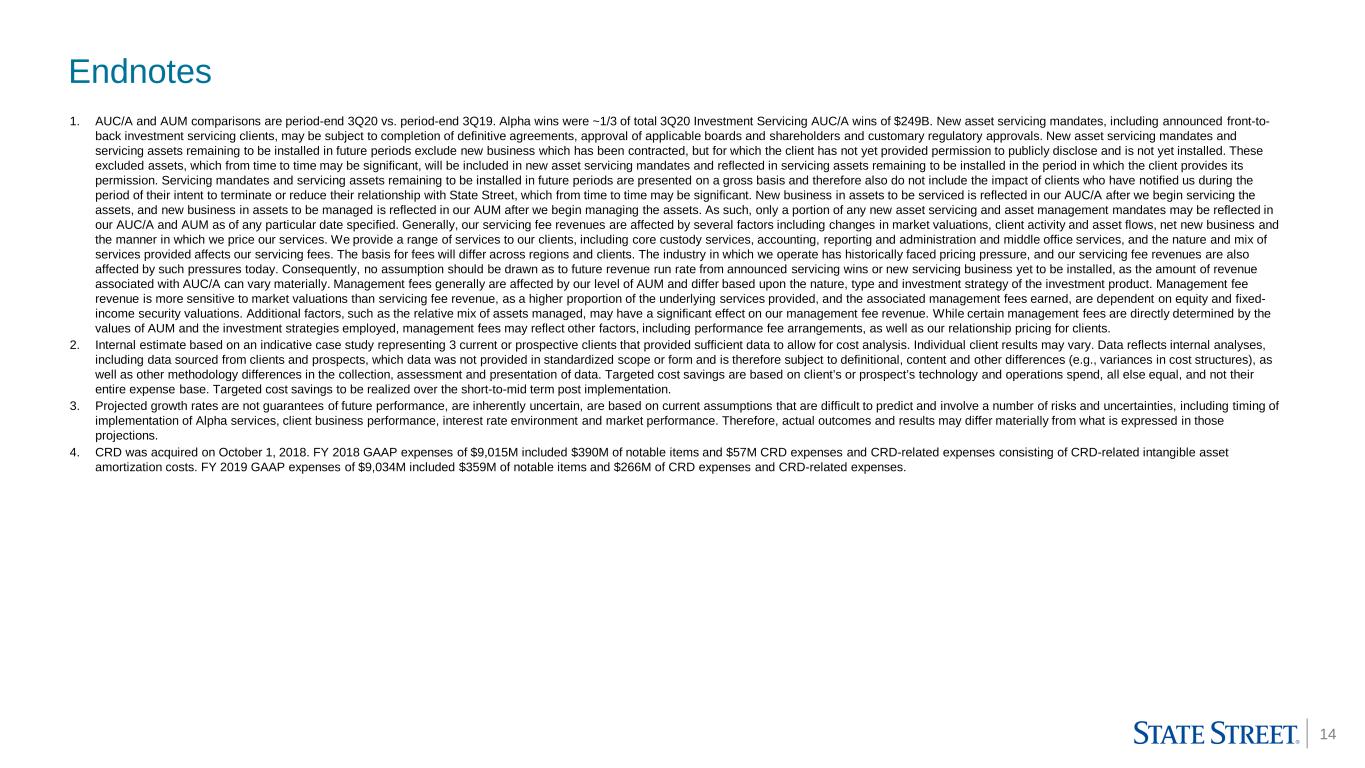
14 Endnotes 1. AUC/A and AUM comparisons are period-end 3Q20 vs. period-end 3Q19. Alpha wins were ~1/3 of total 3Q20 Investment Servicing AUC/A wins of $249B. New asset servicing mandates, including announced front-to- back investment servicing clients, may be subject to completion of definitive agreements, approval of applicable boards and shareholders and customary regulatory approvals. New asset servicing mandates and servicing assets remaining to be installed in future periods exclude new business which has been contracted, but for which the client has not yet provided permission to publicly disclose and is not yet installed. These excluded assets, which from time to time may be significant, will be included in new asset servicing mandates and reflected in servicing assets remaining to be installed in the period in which the client provides its permission. Servicing mandates and servicing assets remaining to be installed in future periods are presented on a gross basis and therefore also do not include the impact of clients who have notified us during the period of their intent to terminate or reduce their relationship with State Street, which from time to time may be significant. New business in assets to be serviced is reflected in our AUC/A after we begin servicing the assets, and new business in assets to be managed is reflected in our AUM after we begin managing the assets. As such, only a portion of any new asset servicing and asset management mandates may be reflected in our AUC/A and AUM as of any particular date specified. Generally, our servicing fee revenues are affected by several factors including changes in market valuations, client activity and asset flows, net new business and the manner in which we price our services. We provide a range of services to our clients, including core custody services, accounting, reporting and administration and middle office services, and the nature and mix of services provided affects our servicing fees. The basis for fees will differ across regions and clients. The industry in which we operate has historically faced pricing pressure, and our servicing fee revenues are also affected by such pressures today. Consequently, no assumption should be drawn as to future revenue run rate from announced servicing wins or new servicing business yet to be installed, as the amount of revenue associated with AUC/A can vary materially. Management fees generally are affected by our level of AUM and differ based upon the nature, type and investment strategy of the investment product. Management fee revenue is more sensitive to market valuations than servicing fee revenue, as a higher proportion of the underlying services provided, and the associated management fees earned, are dependent on equity and fixed- income security valuations. Additional factors, such as the relative mix of assets managed, may have a significant effect on our management fee revenue. While certain management fees are directly determined by the values of AUM and the investment strategies employed, management fees may reflect other factors, including performance fee arrangements, as well as our relationship pricing for clients. 2. Internal estimate based on an indicative case study representing 3 current or prospective clients that provided sufficient data to allow for cost analysis. Individual client results may vary. Data reflects internal analyses, including data sourced from clients and prospects, which data was not provided in standardized scope or form and is therefore subject to definitional, content and other differences (e.g., variances in cost structures), as well as other methodology differences in the collection, assessment and presentation of data. Targeted cost savings are based on client’s or prospect’s technology and operations spend, all else equal, and not their entire expense base. Targeted cost savings to be realized over the short-to-mid term post implementation. 3. Projected growth rates are not guarantees of future performance, are inherently uncertain, are based on current assumptions that are difficult to predict and involve a number of risks and uncertainties, including timing of implementation of Alpha services, client business performance, interest rate environment and market performance. Therefore, actual outcomes and results may differ materially from what is expressed in those projections. 4. CRD was acquired on October 1, 2018. FY 2018 GAAP expenses of $9,015M included $390M of notable items and $57M CRD expenses and CRD-related expenses consisting of CRD-related intangible asset amortization costs. FY 2019 GAAP expenses of $9,034M included $359M of notable items and $266M of CRD expenses and CRD-related expenses.
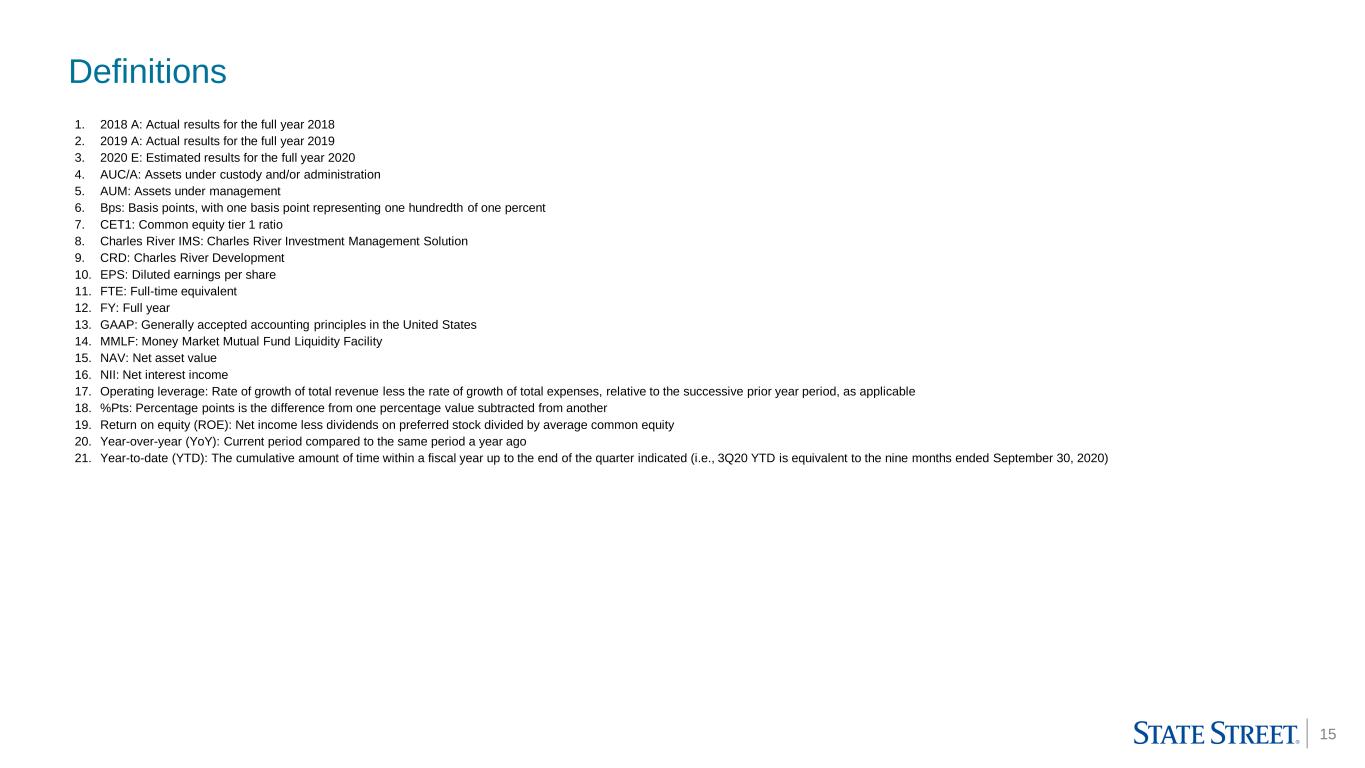
15 Definitions 1. 2018 A: Actual results for the full year 2018 2. 2019 A: Actual results for the full year 2019 3. 2020 E: Estimated results for the full year 2020 4. AUC/A: Assets under custody and/or administration 5. AUM: Assets under management 6. Bps: Basis points, with one basis point representing one hundredth of one percent 7. CET1: Common equity tier 1 ratio 8. Charles River IMS: Charles River Investment Management Solution 9. CRD: Charles River Development 10. EPS: Diluted earnings per share 11. FTE: Full-time equivalent 12. FY: Full year 13. GAAP: Generally accepted accounting principles in the United States 14. MMLF: Money Market Mutual Fund Liquidity Facility 15. NAV: Net asset value 16. NII: Net interest income 17. Operating leverage: Rate of growth of total revenue less the rate of growth of total expenses, relative to the successive prior year period, as applicable 18. %Pts: Percentage points is the difference from one percentage value subtracted from another 19. Return on equity (ROE): Net income less dividends on preferred stock divided by average common equity 20. Year-over-year (YoY): Current period compared to the same period a year ago 21. Year-to-date (YTD): The cumulative amount of time within a fiscal year up to the end of the quarter indicated (i.e., 3Q20 YTD is equivalent to the nine months ended September 30, 2020)

16 Non-GAAP measures In addition to presenting State Street's financial results in conformity with U.S. generally accepted accounting principles, or GAAP, management also presents certain financial information on a basis that excludes or adjusts one or more items from GAAP. This latter basis is a non-GAAP presentation. In general, our non- GAAP financial results adjust selected GAAP-basis financial results to exclude the impact of revenue and expenses outside of State Street’s normal course of business or other notable items, such as acquisition and restructuring charges, repositioning charges, gains/losses on sales, as well as, for selected comparisons, seasonal items. For example, we sometimes present expenses on a basis we may refer to as “expenses ex-notable items", which exclude notable items and, to provide additional perspective on both prior year quarter and sequential quarter comparisons, also exclude seasonal items. Management believes that this presentation of financial information facilitates an investor's further understanding and analysis of State Street's financial performance and trends with respect to State Street’s business operations from period-to-period, including providing additional insight into our underlying margin and profitability. In addition, Management may also provide additional non-GAAP measures. For example, we present capital ratios, calculated under regulatory standards scheduled to be effective in the future or other standards, that management uses in evaluating State Street’s business and activities and believes may similarly be useful to investors. Additionally, we may present revenue and expense measures on a constant currency basis to identify the significance of changes in foreign currency exchange rates (which often are variable) in period-to-period comparisons. This presentation represents the effects of applying prior period weighted average foreign currency exchange rates to current period results. Non-GAAP financial measures should be considered in addition to, not as a substitute for or superior to, financial measures determined in conformity with GAAP.
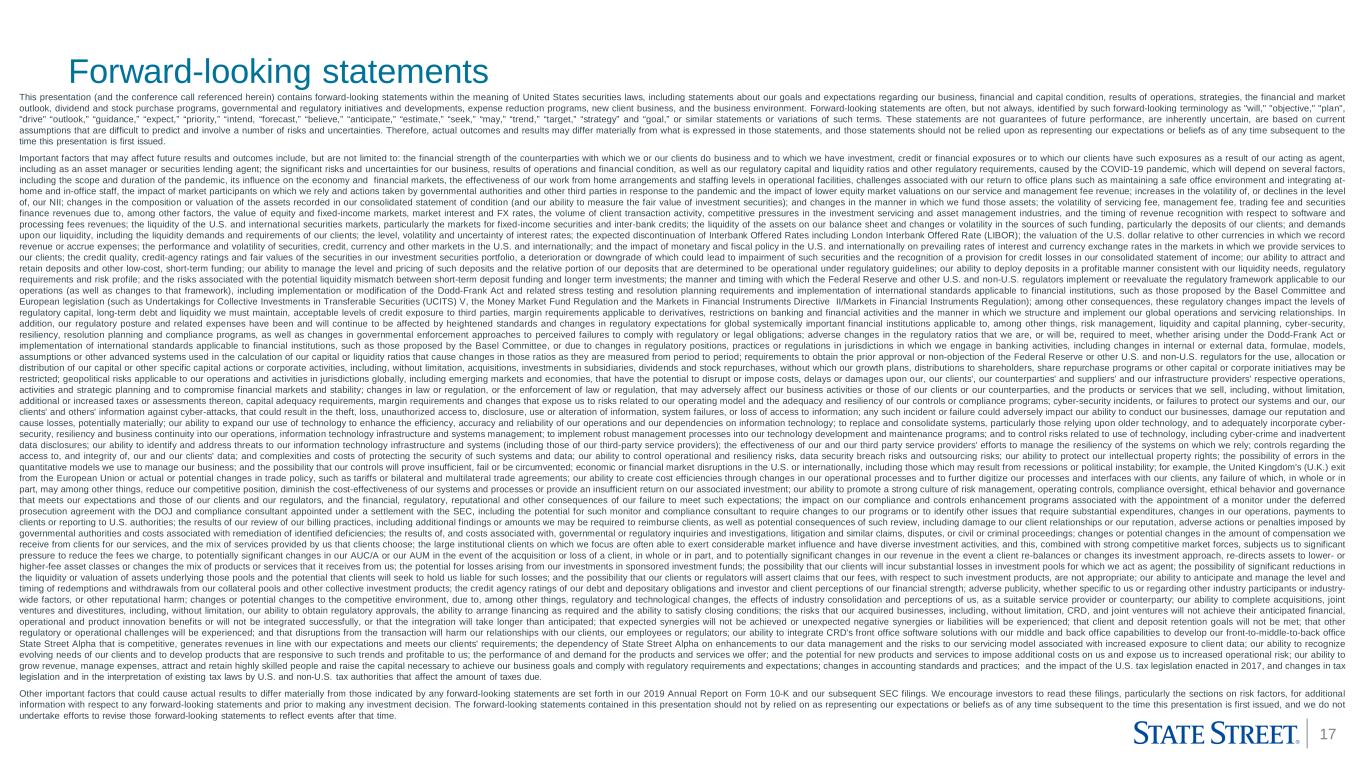
17 Forward-looking statements This presentation (and the conference call referenced herein) contains forward-looking statements within the meaning of United States securities laws, including statements about our goals and expectations regarding our business, financial and capital condition, results of operations, strategies, the financial and market outlook, dividend and stock purchase programs, governmental and regulatory initiatives and developments, expense reduction programs, new client business, and the business environment. Forward-looking statements are often, but not always, identified by such forward-looking terminology as "will," "objective," "plan", "drive" “outlook,” “guidance,” “expect,” “priority,” “intend, “forecast,” “believe,” “anticipate,” “estimate,” “seek,” “may,” “trend,” “target,” “strategy” and “goal,” or similar statements or variations of such terms. These statements are not guarantees of future performance, are inherently uncertain, are based on current assumptions that are difficult to predict and involve a number of risks and uncertainties. Therefore, actual outcomes and results may differ materially from what is expressed in those statements, and those statements should not be relied upon as representing our expectations or beliefs as of any time subsequent to the time this presentation is first issued. Important factors that may affect future results and outcomes include, but are not limited to: the financial strength of the counterparties with which we or our clients do business and to which we have investment, credit or financial exposures or to which our clients have such exposures as a result of our acting as agent, including as an asset manager or securities lending agent; the significant risks and uncertainties for our business, results of operations and financial condition, as well as our regulatory capital and liquidity ratios and other regulatory requirements, caused by the COVID-19 pandemic, which will depend on several factors, including the scope and duration of the pandemic, its influence on the economy and financial markets, the effectiveness of our work from home arrangements and staffing levels in operational facilities, challenges associated with our return to office plans such as maintaining a safe office environment and integrating at- home and in-office staff, the impact of market participants on which we rely and actions taken by governmental authorities and other third parties in response to the pandemic and the impact of lower equity market valuations on our service and management fee revenue; increases in the volatility of, or declines in the level of, our NII; changes in the composition or valuation of the assets recorded in our consolidated statement of condition (and our ability to measure the fair value of investment securities); and changes in the manner in which we fund those assets; the volatility of servicing fee, management fee, trading fee and securities finance revenues due to, among other factors, the value of equity and fixed-income markets, market interest and FX rates, the volume of client transaction activity, competitive pressures in the investment servicing and asset management industries, and the timing of revenue recognition with respect to software and processing fees revenues; the liquidity of the U.S. and international securities markets, particularly the markets for fixed-income securities and inter-bank credits; the liquidity of the assets on our balance sheet and changes or volatility in the sources of such funding, particularly the deposits of our clients; and demands upon our liquidity, including the liquidity demands and requirements of our clients; the level, volatility and uncertainty of interest rates; the expected discontinuation of Interbank Offered Rates including London Interbank Offered Rate (LIBOR); the valuation of the U.S. dollar relative to other currencies in which we record revenue or accrue expenses; the performance and volatility of securities, credit, currency and other markets in the U.S. and internationally; and the impact of monetary and fiscal policy in the U.S. and internationally on prevailing rates of interest and currency exchange rates in the markets in which we provide services to our clients; the credit quality, credit-agency ratings and fair values of the securities in our investment securities portfolio, a deterioration or downgrade of which could lead to impairment of such securities and the recognition of a provision for credit losses in our consolidated statement of income; our ability to attract and retain deposits and other low-cost, short-term funding; our ability to manage the level and pricing of such deposits and the relative portion of our deposits that are determined to be operational under regulatory guidelines; our ability to deploy deposits in a profitable manner consistent with our liquidity needs, regulatory requirements and risk profile; and the risks associated with the potential liquidity mismatch between short-term deposit funding and longer term investments; the manner and timing with which the Federal Reserve and other U.S. and non-U.S. regulators implement or reevaluate the regulatory framework applicable to our operations (as well as changes to that framework), including implementation or modification of the Dodd-Frank Act and related stress testing and resolution planning requirements and implementation of international standards applicable to financial institutions, such as those proposed by the Basel Committee and European legislation (such as Undertakings for Collective Investments in Transferable Securities (UCITS) V, the Money Market Fund Regulation and the Markets in Financial Instruments Directive II/Markets in Financial Instruments Regulation); among other consequences, these regulatory changes impact the levels of regulatory capital, long-term debt and liquidity we must maintain, acceptable levels of credit exposure to third parties, margin requirements applicable to derivatives, restrictions on banking and financial activities and the manner in which we structure and implement our global operations and servicing relationships. In addition, our regulatory posture and related expenses have been and will continue to be affected by heightened standards and changes in regulatory expectations for global systemically important financial institutions applicable to, among other things, risk management, liquidity and capital planning, cyber-security, resiliency, resolution planning and compliance programs, as well as changes in governmental enforcement approaches to perceived failures to comply with regulatory or legal obligations; adverse changes in the regulatory ratios that we are, or will be, required to meet, whether arising under the Dodd-Frank Act or implementation of international standards applicable to financial institutions, such as those proposed by the Basel Committee, or due to changes in regulatory positions, practices or regulations in jurisdictions in which we engage in banking activities, including changes in internal or external data, formulae, models, assumptions or other advanced systems used in the calculation of our capital or liquidity ratios that cause changes in those ratios as they are measured from period to period; requirements to obtain the prior approval or non-objection of the Federal Reserve or other U.S. and non-U.S. regulators for the use, allocation or distribution of our capital or other specific capital actions or corporate activities, including, without limitation, acquisitions, investments in subsidiaries, dividends and stock repurchases, without which our growth plans, distributions to shareholders, share repurchase programs or other capital or corporate initiatives may be restricted; geopolitical risks applicable to our operations and activities in jurisdictions globally, including emerging markets and economies, that have the potential to disrupt or impose costs, delays or damages upon our, our clients', our counterparties' and suppliers' and our infrastructure providers' respective operations, activities and strategic planning and to compromise financial markets and stability; changes in law or regulation, or the enforcement of law or regulation, that may adversely affect our business activities or those of our clients or our counterparties, and the products or services that we sell, including, without limitation, additional or increased taxes or assessments thereon, capital adequacy requirements, margin requirements and changes that expose us to risks related to our operating model and the adequacy and resiliency of our controls or compliance programs; cyber-security incidents, or failures to protect our systems and our, our clients' and others' information against cyber-attacks, that could result in the theft, loss, unauthorized access to, disclosure, use or alteration of information, system failures, or loss of access to information; any such incident or failure could adversely impact our ability to conduct our businesses, damage our reputation and cause losses, potentially materially; our ability to expand our use of technology to enhance the efficiency, accuracy and reliability of our operations and our dependencies on information technology; to replace and consolidate systems, particularly those relying upon older technology, and to adequately incorporate cyber- security, resiliency and business continuity into our operations, information technology infrastructure and systems management; to implement robust management processes into our technology development and maintenance programs; and to control risks related to use of technology, including cyber-crime and inadvertent data disclosures; our ability to identify and address threats to our information technology infrastructure and systems (including those of our third-party service providers); the effectiveness of our and our third party service providers' efforts to manage the resiliency of the systems on which we rely; controls regarding the access to, and integrity of, our and our clients' data; and complexities and costs of protecting the security of such systems and data; our ability to control operational and resiliency risks, data security breach risks and outsourcing risks; our ability to protect our intellectual property rights; the possibility of errors in the quantitative models we use to manage our business; and the possibility that our controls will prove insufficient, fail or be circumvented; economic or financial market disruptions in the U.S. or internationally, including those which may result from recessions or political instability; for example, the United Kingdom's (U.K.) exit from the European Union or actual or potential changes in trade policy, such as tariffs or bilateral and multilateral trade agreements; our ability to create cost efficiencies through changes in our operational processes and to further digitize our processes and interfaces with our clients, any failure of which, in whole or in part, may among other things, reduce our competitive position, diminish the cost-effectiveness of our systems and processes or provide an insufficient return on our associated investment; our ability to promote a strong culture of risk management, operating controls, compliance oversight, ethical behavior and governance that meets our expectations and those of our clients and our regulators, and the financial, regulatory, reputational and other consequences of our failure to meet such expectations; the impact on our compliance and controls enhancement programs associated with the appointment of a monitor under the deferred prosecution agreement with the DOJ and compliance consultant appointed under a settlement with the SEC, including the potential for such monitor and compliance consultant to require changes to our programs or to identify other issues that require substantial expenditures, changes in our operations, payments to clients or reporting to U.S. authorities; the results of our review of our billing practices, including additional findings or amounts we may be required to reimburse clients, as well as potential consequences of such review, including damage to our client relationships or our reputation, adverse actions or penalties imposed by governmental authorities and costs associated with remediation of identified deficiencies; the results of, and costs associated with, governmental or regulatory inquiries and investigations, litigation and similar claims, disputes, or civil or criminal proceedings; changes or potential changes in the amount of compensation we receive from clients for our services, and the mix of services provided by us that clients choose; the large institutional clients on which we focus are often able to exert considerable market influence and have diverse investment activities, and this, combined with strong competitive market forces, subjects us to significant pressure to reduce the fees we charge, to potentially significant changes in our AUC/A or our AUM in the event of the acquisition or loss of a client, in whole or in part, and to potentially significant changes in our revenue in the event a client re-balances or changes its investment approach, re-directs assets to lower- or higher-fee asset classes or changes the mix of products or services that it receives from us; the potential for losses arising from our investments in sponsored investment funds; the possibility that our clients will incur substantial losses in investment pools for which we act as agent; the possibility of significant reductions in the liquidity or valuation of assets underlying those pools and the potential that clients will seek to hold us liable for such losses; and the possibility that our clients or regulators will assert claims that our fees, with respect to such investment products, are not appropriate; our ability to anticipate and manage the level and timing of redemptions and withdrawals from our collateral pools and other collective investment products; the credit agency ratings of our debt and depositary obligations and investor and client perceptions of our financial strength; adverse publicity, whether specific to us or regarding other industry participants or industry- wide factors, or other reputational harm; changes or potential changes to the competitive environment, due to, among other things, regulatory and technological changes, the effects of industry consolidation and perceptions of us, as a suitable service provider or counterparty; our ability to complete acquisitions, joint ventures and divestitures, including, without limitation, our ability to obtain regulatory approvals, the ability to arrange financing as required and the ability to satisfy closing conditions; the risks that our acquired businesses, including, without limitation, CRD, and joint ventures will not achieve their anticipated financial, operational and product innovation benefits or will not be integrated successfully, or that the integration will take longer than anticipated; that expected synergies will not be achieved or unexpected negative synergies or liabilities will be experienced; that client and deposit retention goals will not be met; that other regulatory or operational challenges will be experienced; and that disruptions from the transaction will harm our relationships with our clients, our employees or regulators; our ability to integrate CRD's front office software solutions with our middle and back office capabilities to develop our front-to-middle-to-back office State Street Alpha that is competitive, generates revenues in line with our expectations and meets our clients' requirements; the dependency of State Street Alpha on enhancements to our data management and the risks to our servicing model associated with increased exposure to client data; our ability to recognize evolving needs of our clients and to develop products that are responsive to such trends and profitable to us; the performance of and demand for the products and services we offer; and the potential for new products and services to impose additional costs on us and expose us to increased operational risk; our ability to grow revenue, manage expenses, attract and retain highly skilled people and raise the capital necessary to achieve our business goals and comply with regulatory requirements and expectations; changes in accounting standards and practices; and the impact of the U.S. tax legislation enacted in 2017, and changes in tax legislation and in the interpretation of existing tax laws by U.S. and non-U.S. tax authorities that affect the amount of taxes due. Other important factors that could cause actual results to differ materially from those indicated by any forward-looking statements are set forth in our 2019 Annual Report on Form 10-K and our subsequent SEC filings. We encourage investors to read these filings, particularly the sections on risk factors, for additional information with respect to any forward-looking statements and prior to making any investment decision. The forward-looking statements contained in this presentation should not by relied on as representing our expectations or beliefs as of any time subsequent to the time this presentation is first issued, and we do not undertake efforts to revise those forward-looking statements to reflect events after that time.
















